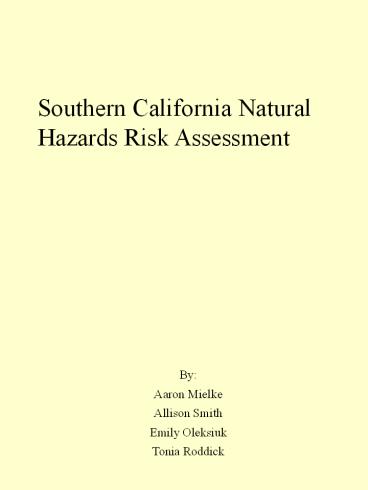Southern California Natural Hazards Risk Assessment - PowerPoint PPT Presentation
Title:
Southern California Natural Hazards Risk Assessment
Description:
Where are the areas of high hazard from natural disasters? ... Obispo. Determining Fire Hazard. Solving the Problem: Data Layers. Fire Rotation Rank townships ... – PowerPoint PPT presentation
Number of Views:88
Avg rating:3.0/5.0
Title: Southern California Natural Hazards Risk Assessment
1
Southern California Natural Hazards Risk
Assessment
By Aaron Mielke Allison Smith Emily
Oleksiuk Tonia Roddick
2
Problem
- Where are the areas of high hazard from natural
disasters? - Are urban areas located in high hazard areas?
3
Earthquakes, Landslides, and Wildfire in Southern
California
- Contributing Factors geology, climate, and
human - use of landscape and resources
4
Earthquakes, Landslides, and Wildfire in Southern
California
- Contributing Factors geology, climate, and
human - use of landscape and resources
- How severe are these hazards and what are their
- effects?
5
Earthquakes, Landslides, and Wildfire in Southern
California
- Contributing Factors geology, climate, and
human - use of landscape and resources
- How severe are these hazards and what are their
- effects?
- Goal of project Determine hazardous areas in
- Southern California and urban areas at high or
- very high risk
6
Earthquakes, Landslides, and Wildfire in Southern
California
- Contributing Factors geology, climate, and
human - use of landscape and resources
- How significant are these hazards and why are
- they a problem?
- Goal of project Determine high risk areas in
- Southern California based on these hazards and
- urban areas at high or very high risk
- Applications of results insurance companies,
- land developers, and disaster preparedness
7
Earthquakes, Landslides, and Wildfire in Southern
California
Study Area Southern California 10 Southern
Counties 57,000 Square Miles
San Luis Obispo
Kern
San Bernardino
Santa Barbara
Los Angeles
Ventura
Riverside
Orange
San Diego
Imperial
8
Solving the Problem
Determining Fire Hazard
- Data Layers
- Fire Rotation ? Rank townships
- Fuel Ranking ? Rank townships
9
Calculating Fire Hazard
Overlay and Rank
10
Solving the Problem
Determining Earthquake Hazard
- Data Layers
- Fault Lines ? Townships ranked by distance from
fault - Historical Earthquakes ? Townships ranked by
EQ/miles2 - Ground Acceleration ? Townships ranked by area
weighted ground acceleration value
11
Calculating Hazard from Fault lines
Buffer/rank
Overlay
Ranking (Distance from faults km) 0
gt25km 1 (20-25km) 2 (15-20km)
3 (10-15km) 4 lt10km
12
Calculating Hazard from Past Earthquakes
Overlay
Rank
Ranking (Earthquakes/mile2) 0 0 1
(0-0.028) 2 (0.028-0.069) 3
(0.069-0.2) 4 gt0.2
13
Calculating Hazard from Ground Acceleration
Overlay
Rank
Ranking (Ground Acceleration) (percent of
gravity) 0 (0-13.6) 1
(13.6-22.8) 2 (22.8-34.8) 3
(34.8-54.8) 4 gt54.8
14
Calculating Overall Earthquake Hazard
Faults
Earthquake
Ground
Overall
15
Solving the Problem
Determining Landslide Hazard
- Data Layers
- Precipitation ? Townships ranked by range of
annual rainfall - Geology ? Townships ranked by hardness of bedrock
- Slope ? Townships ranked by steepness of slope
16
Calculating Hazard from Precipitation
Overlay
Rank
Ranking (Precipitation inches) 0 lt2.5
1 (2.5-7.6) 2 (7.6-12.8) 3
(12.8-18.8) 4 gt18.8
17
Calculating Hazard from Geology
Overlay
Rank
Ranking (Geology) 0 (0-1.2) 1
(1.2-3.1) 2 (3.1-4.1) 3
(4.1-4.6) 4 gt4.6
18
Calculating Hazard from Slope
Overlay
Rank
19
Calculating Overall Landslide Hazard
Precipitation
Geology
Slope
Overall
20
Results
- Hazard Maps
- Fire Hazard
- Earthquake Hazard
- Landslide Hazard
- Overall Hazard
- Urban Map
- Numbers
- Percent of area classified as urban
- Percent of population in urban areas
- Percent of study area classified as high or very
high hazard - Percent of urban area in high or very high hazard
areas - Percent of population in high hazard areas
21
Hazard Maps
Earthquake Hazard
Fire Hazard
Landslide Hazard
Overall Hazard
22
Urban Areas in Southern California
Los Angeles
San Diego
23
Urban areas overlayed on Hazard Map
Urban Areas
- Study area
- 57,115 square miles
- 20,637,304 people
- Urban Areas 500 people/square mile or more
- 3,158 square miles - 5.5 of Study area
- 20,065,398 people - 97.2 of Study area
population
- High or Very High Hazard Areas
- 25,500 square miles - 42 of Study area
- Urban Areas at High or Very High Risk
- 2011 square miles - 63 of urban areas are in
high or very high hazard areas - - 3.4 of Study area is
Urban and high or very high hazard area - 12,414,461 people - 62 of urban area population
- - 60 of Study area
population
24
Improvements
Fire Components of fire were averageda weighted
average (as was done with the
earthquake components) would probably be more
accurate Earthquake Faults were all buffered
equallyit would be more accurate
to put a heavier weight on faults that are more
active than those that are less
active. We used a straight count
for the number of earthquakes per townshipit
would be more accurate to weight
this count by magnitude Landslide We used
average annual precipitation in the landslide
section precipitation intensity
data would have been useful Urban We determined
the threat to urban areas in terms of population
densitythis does not take into
account expensive structures in less
populated areas
25
Questions?































